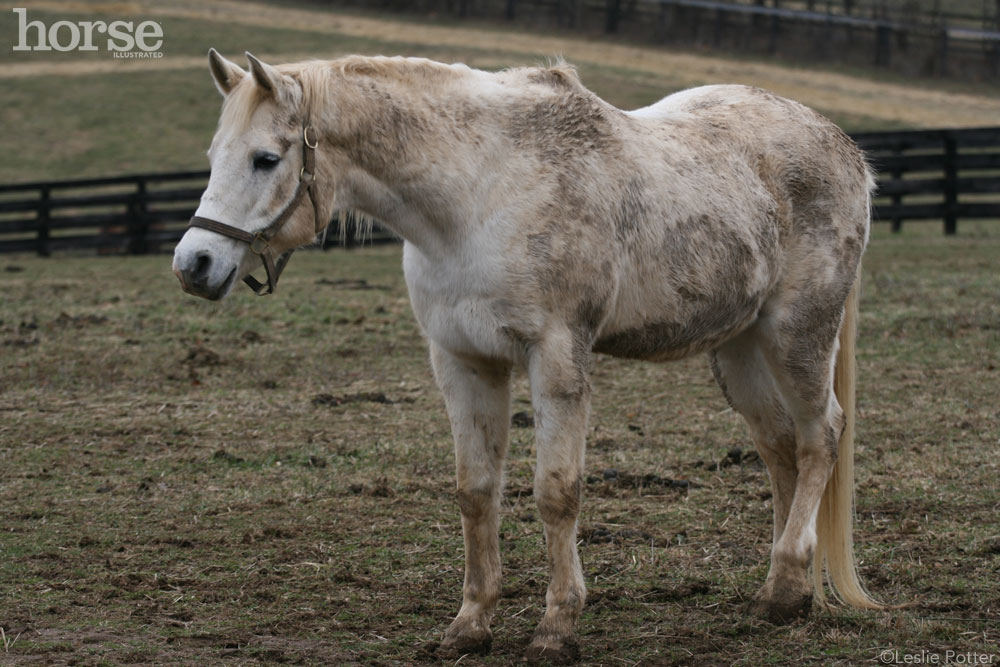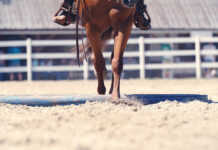It’s mud, mud everywhere this time of year. While horse owners welcome with open arms the warmth of spring after a long winter, the oscillating temperatures and crazy mix of precipitation can make the most stoic of us wish for the dog days of summer. Other than soggy trail rides, the mood swings of spring also bring us some special hoof health issues to consider. Read more to find out what to watch for with muddy hooves.

Mud fever
Could a mud-caused malady been any better named? Also known as scratches, greasy heel, and dew poisoning, mud fever is a skin condition that occurs most commonly along the backside of the pastern and is clinically called pastern dermatitis.
Mud fever occurs most frequently in horses that are constantly standing in wet, muddy pastures. Early spring and late fall are common times to encounter this condition, when fields are awash with rain, snow, or ice melt. Constant exposure to moisture can break down the skin’s natural barriers against infection. This allows bacteria and sometimes fungi to invade. Resultant local infection develops, leading to red, raw, tender skin that scabs and flakes. Particularly sensitive horses might experience some swelling around the pastern and transient mild lameness. Sores on the back of the pastern right above the heel are the classic sign of mud fever.
The key to both prevention and cure of mud fever is to keep your horse’s lower legs and feet dry. If your pastures are exceedingly wet and sloppy, your horse may have to spend upwards of a week or more in his stall to give his skin time to dry and heal. If this is the case, be sure to keep the stall clean and dry. Shavings are the best bedding for healing mud fever.
Topical treatments commonly used for mud fever act to further help dry the skin. Delicate washings with a dilute iodine solution will help dry and cleanse the skin. Other antibacterial shampoos can be used as well, but ask your veterinarian which is the best choice for your horse.
After washings, be sure to completely dry your horse’s legs. Paper towels or thin cotton rags are easy to use, easily soak up moisture, and are disposable. Don’t re-use dirty towels for drying.
You will be able to monitor healing as you begin to see the skin scab and flake. Your veterinarian will be able to advise you on how often to wash and for how long, based on how badly your horse is affected.
Even though bacteria commonly cause mud fever, antibiotics are rarely prescribed unless severe swelling and lameness are evident or there are signs of a more serious infection. Most frequently, mud fever is limited to small areas of the skin which, when dried and cleaned, can retain its original capacity to fight infection on its own.
Thrush
Pesky bacteria can cause another common problem when the weather is wet. Thrush is the name of the hoof condition characterized by black, foul-smelling discharge that originates from the sole of the hoof, usually around the central and lateral sulci, which are the grooves on top of and along the sides of the frog.
Unlike mud fever, which can have different bacterial culprits, the cause of thrush is singular—a bacterium called Fusobacterium necrophorum. This bacterium thrives in damp, dark conditions, such as those of the deep recesses of the hoof, especially in wet weather, although hoof conformation and lack of exercise also play a role in the development of thrush in some horses.
Mild thrush can merely be an annoyance, but all cases of thrush should be treated. If thrush is ignored, it can continually fester. The infection can then spread deeper than the frog and invade the sensitive tissues of the hoof, causing lameness and becoming far more difficult to treat. Early recognition of this condition and treatment are the easiest ways to manage thrush.
As with mud fever, environmental management and topical treatments are key in controlling this condition. Keeping your horse’s feet as dry and clean as possible during thrush treatment is important. Twice or even three-times daily hoof cleanings should be done to help clean out the deep sulci around the frog. If your horse has thrush, don’t use his hoof pick on another horse and thoroughly clean the pick between each use on your own horse. Have your farrier come out to trim away the dead and infected portions of your horse’s frog.
Topical medications abound for thrush treatment and are easily purchased at your feed store. Some people prefer the ease of dilute bleach or iodine. Most thrush treatments have an element of antimicrobial action, but they also act as a drying agent. If you’re not sure which treatment is right for your horse, or how often to apply it, ask your veterinarian.
Shoe-eating mud
The bemoaning of hoof problems due to mud wouldn’t be complete until we mention the plight of lost shoes.
A lost shoe in a muddy pasture can sometimes feel like the proverbial needle in a haystack. Really thick mud acts as a suction device, as anyone who has ever lost a boot in it will know. Horses experience the same effect and if there’s even a hint of a loose nail, this suction may be enough to simply pull the entire shoe right off.
While not a medical issue on its own, the farrier should see a horse with a missing shoe in a timely manner. It’s not recommended to ride a horse with a missing shoe since unevenness in wear and footing can make it dangerous and uncomfortable for the horse.
While you wait for the farrier, be sure to take a good look at the naked hoof. Often a chunk of the hoof wall has been ripped out with a nail. Although this can look dramatic, it usually isn’t, especially if the horse’s hooves were in need of a trim anyway. The farrier will be able to file off any sharp or uneven edges.
A horse that has just lost a shoe may seem lame at the start. This may be because he is tender-footed on the bare foot, or maybe a piece of hoof wall that has come off is close to the sensitive portion of the foot. If your horse appears extremely lame, have the farrier out immediately and consider calling your veterinarian for a more thorough exam. If your horse has wrenched his foot from a deep pocket of mud, there is the chance of a strain or sprain.
No matter what the cause of your horse’s muddy weather woes, a few bits of mud management are key: try to house your horse in as dry a location as possible and pick your horse’s hooves at least once daily.
Liked this article? Here are others on managing mud:
Mud-Related Health Problems
Mud Management for Horse Owners
Corral Mud Management






r
Nice article, and certainly have dealt with scratches. Tried everything you have written about, and then some. Then tried Banixx. Spray it on, scabs dry up and fall off. No hair loss, no painful scrubbing, no washing, no stress for horse or human. Just spray it on. Good stuff.D
Great advice.
We always washed the affected area, dried well then clipped the hair short and applied Desitin paste, the diaper rash ointment. Works very well and doesnt cone off so easy if the area gets wet.
We used to use Oil of Thuja not sure if you can still get it for scratches ( mud fever). Also dilute bleach in water for thrush. ???